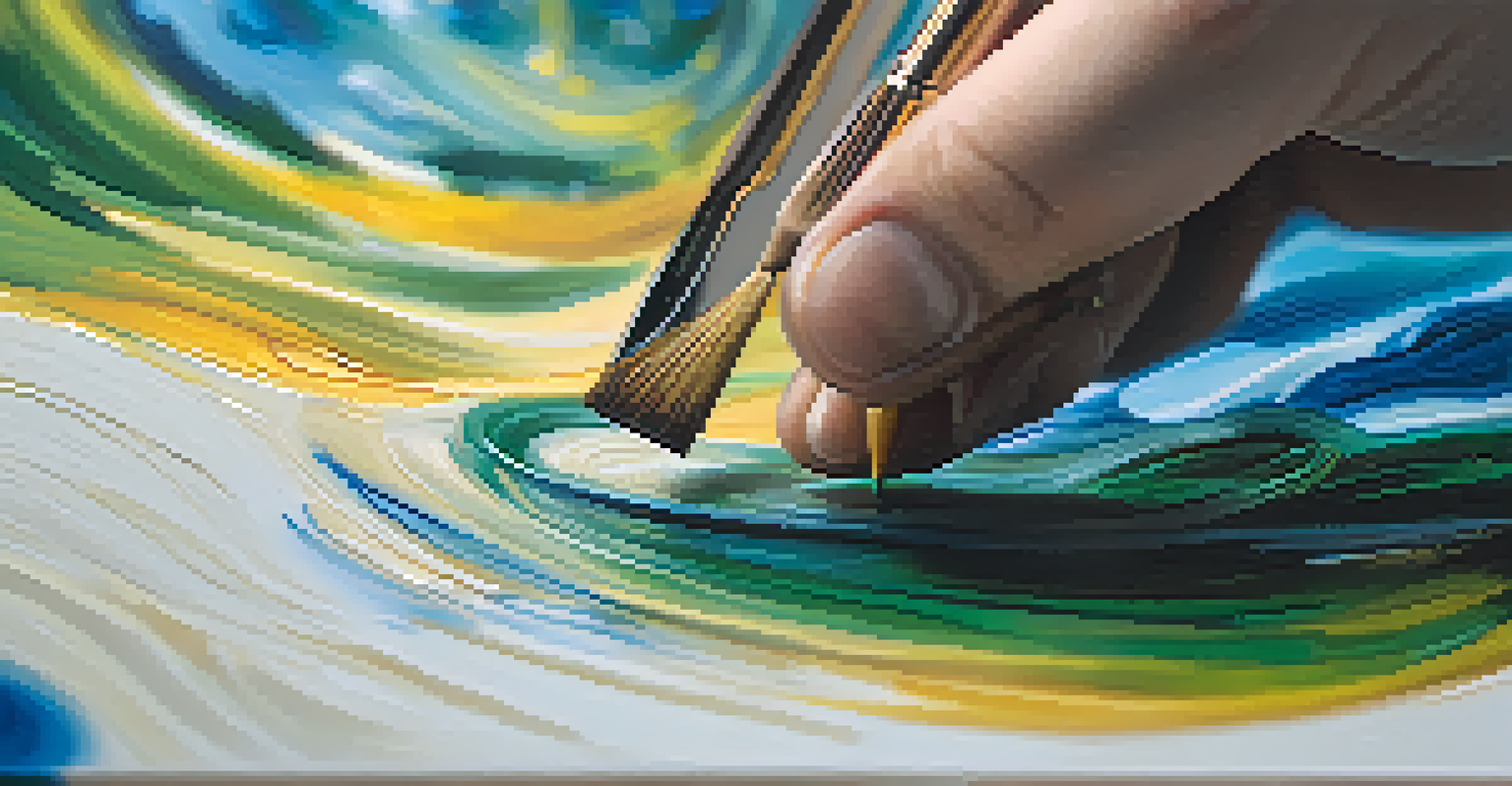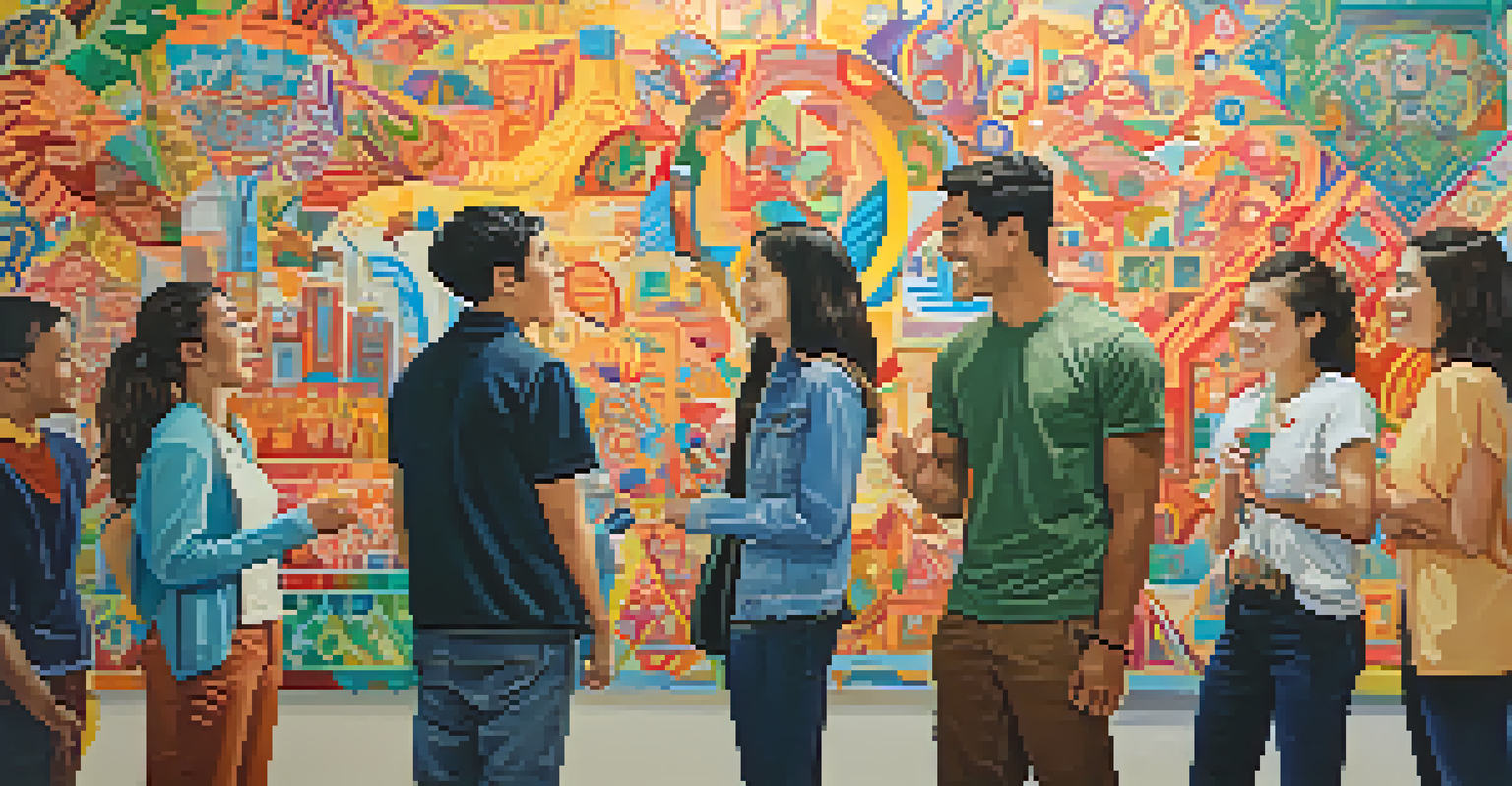Enhancing Communication Skills Through Art Education

The Connection Between Art and Communication Skills
Art and communication are deeply intertwined, as both involve expressing ideas and emotions. Engaging in art education allows students to convey their thoughts visually, which can significantly enhance their verbal communication skills. For instance, when students create a painting, they learn to articulate the story behind their artwork, fostering clarity in expression.
Art is the most beautiful of all lies; it is a bridge between the soul and the world, a means of communication that transcends words.
Moreover, art encourages the use of non-verbal communication. Through body language, facial expressions, and the choice of colors, students learn to convey messages without words. This is particularly beneficial in developing empathy, as they start to understand how different forms of expression affect others.
By participating in art projects, students also engage in collaborative discussions. Whether they are working on a group mural or critiquing each other's work, they practice articulating their opinions and responding to feedback, which are vital components of effective communication.
Art Education Fosters Active Listening Skills
Active listening is crucial in communication, and art education provides a unique platform for honing this skill. When students participate in group critiques or discussions about art, they must listen attentively to others' perspectives. This practice helps them learn to appreciate diverse viewpoints, a key aspect of effective communication.

In the context of art, listening goes beyond just hearing words; it involves understanding the emotions and intentions behind those words. For example, when a peer shares their artistic process, students learn to interpret feelings and motivations, which enhances their overall comprehension and responsiveness in conversations.
Art Boosts Communication Skills
Engaging in art education enhances both verbal and non-verbal communication by encouraging expression and understanding of diverse perspectives.
Furthermore, the collaborative nature of many art projects requires students to listen closely to their teammates. By valuing each other's input and ideas, they build a stronger sense of community, which naturally contributes to improved communication skills both in and out of the classroom.
Enhancing Confidence Through Artistic Expression
Engaging in art education can significantly boost a student's confidence, especially in their ability to communicate. When students create and share their artwork, they often find pride in their expressions, which translates into greater self-assurance in verbal interactions. This newfound confidence encourages them to participate more actively in discussions.
The purpose of art is not a rarified, intellectual distillate; it is life, intensified, brilliant, and immediate, reflecting the complexity of human communication.
For many students, presenting their artwork in front of peers can be a daunting task. However, overcoming this challenge helps them build resilience and poise, which are essential traits for effective communicators. It’s similar to public speaking—once they conquer the fear of presenting, they become more comfortable sharing their ideas in various settings.
Additionally, as students receive constructive feedback on their art, they learn to accept criticism gracefully. This ability to handle feedback positively is crucial in all forms of communication, allowing them to grow and adapt their ideas while maintaining their self-esteem.
Creative Problem-Solving in Art Education
Art education encourages students to think creatively, which is a vital skill in communication. When faced with artistic challenges, such as how to represent a complex emotion visually, students learn to brainstorm and articulate their thought processes. This not only enhances their creative skills but also their ability to express ideas clearly.
Creative problem-solving involves collaboration, and art projects often require teamwork. As students navigate different opinions and ideas, they practice negotiation and compromise, enhancing their ability to communicate effectively in group settings. This experience is invaluable in preparing them for real-world scenarios where collaboration is key.
Active Listening Through Art
Art education promotes active listening skills by fostering an environment where students appreciate and interpret different viewpoints during critiques.
Furthermore, the iterative nature of art, where students may need to revise their work based on feedback, teaches them to communicate their ideas flexibly. They learn to explain their reasoning behind changes and how to articulate their vision clearly to others, making them more adept at expressing complex concepts.
Art as a Tool for Emotional Expression and Communication
Art serves as a powerful medium for emotional expression, which is closely tied to effective communication. Students often use their artistic endeavors to convey feelings they may struggle to express verbally. Through painting, drawing, or sculpture, they learn to identify and articulate their emotions, which enhances their emotional intelligence.
Understanding and expressing emotions is crucial in communication, as it allows individuals to connect on a deeper level. For instance, a student who creates a piece reflecting their struggles may find it easier to discuss those feelings with peers. This connection fosters a supportive environment where open dialogue becomes the norm.
Moreover, discussing the emotions behind their artwork enables students to practice empathy. They learn to appreciate how others might feel in similar situations, which enriches their communication skills and prepares them to engage in more meaningful conversations.
Building Cultural Awareness Through Art Education
Art education often exposes students to diverse cultures and perspectives, enhancing their communication skills in multicultural environments. By studying various artistic traditions, students learn to appreciate the richness of different backgrounds, which broadens their understanding of global communication styles. This cultural awareness is invaluable in today's interconnected world.
When students create art inspired by different cultures, they not only learn about those cultures but also how to communicate respectfully and effectively with individuals from diverse backgrounds. This practice helps them develop a more inclusive approach to communication, recognizing that different cultures may express ideas in unique ways.
Confidence Grows with Artistic Expression
Creating and sharing artwork helps students build confidence, which translates into improved verbal communication and resilience in discussions.
Additionally, discussions about cultural art forms encourage students to engage in dialogue about social issues and histories. This fosters critical thinking and the ability to articulate informed opinions, equipping them with the skills needed to navigate complex conversations in an increasingly diverse society.
The Impact of Art Education on Academic Communication Skills
Art education contributes positively to overall academic performance, particularly in communication-related subjects. As students engage in art, they develop skills such as critical thinking, analysis, and the ability to articulate their thoughts clearly—skills that are transferable to writing essays or participating in discussions in subjects like literature or social studies.
For instance, when students analyze artwork, they practice skills like observation and interpretation. These skills are directly applicable in academic settings, where they are required to analyze texts or presentations. Thus, art education indirectly enhances their academic communication abilities.

Moreover, the confidence gained from presenting art can translate into improved performance in verbal assessments or class discussions. As students become more comfortable expressing their ideas in art, they also become more adept at sharing their thoughts in academic environments, leading to a more well-rounded educational experience.